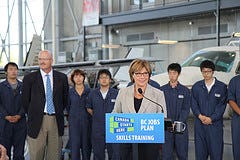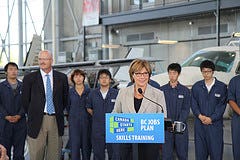“A skilled workforce is the foundation of a strong and resilient economy,” said Premier Clark. “I’ve always said that our province’s best asset is our people, and our government is committed to ensuring British Columbians have the right skills for the job opportunities of today and tomorrow.”

Christy Clark announcing the Government’s plan for a more effective skills and training system
As part of ‘Canada Starts Here: the BC Jobs Plan’, Premier Clark announced that the B.C. government’s plan for a more effective skills and training system will be built on four key areas of action:
• Promoting and profiling today’s training for tomorrow’s careers: government will work to promote the dynamic opportunities in the trades and technical fields and improve policies to support these choices.
• Investing $75 million to improve training facilities and equipment, and ensuring the availability of technical education teachers, particularly with trades certification.
• Getting the right mix and quality of trades and technical programs and reducing the time required to achieve certification while maintaining the high standards required by employers.
• Matching economic immigration selection to meet British Columbia’s labour market needs.
“Our plan ensures that B.C. can supply more skilled workers, more quickly, to meet industry needs. We are taking action to ensure that British Columbians have the skills and supports they need to get the jobs that come with economic growth,” said Minister of Jobs, Tourism and Skills Training and Minister Responsible for Labour Pat Bell.
The changes announced today will help create a pool of skilled talent that puts British Columbians first in line to take advantage of the opportunities that result from the large investments the province is currently experiencing.
The estimated investment for all major projects currently under construction – projects ranging from shipbuilding to natural gas, mining to manufacturing and transportation to commercial/ residential development – is approximately $80 billion, an increase of $11.7 billion since June 2011. $48 billion is projected to be invested in liquefied natural gas (LNG) alone between 2013 and 2022.
“Over the past decade, our government has invested in an education and training system that we can all be proud of – one that is capable of meeting today and tomorrow’s workforce needs,” said Minister of Advanced Education, Innovation and Technology and Minister Responsible for Multiculturalism John Yap. “There’s a reason why students from across Canada and around the world come to B.C. to learn, and why our own students stay. It’s affordable, relevant and renowned. This strategy gives families one more reason to move here, learn here and work here for decades to come.
“We have a tremendous education and training system in our province, but we need to ensure it can evolve to meet the needs of students and the realities of a changing world. We are responding to the growing demand for skilled workers in B.C. by taking steps to ensure K-12 students have the opportunity to choose and pursue quality trades training programs in school and to achieve success in technical fields after they graduate.”
Quotes:
Laurie Rancourt, president and CEO of Northern Lights College – “At Northern Lights College, we are in the heart of B.C.’s energy industry. Here in northern B.C., communities and industries are not facing a ‘looming’ skills shortage; in fact, we are already in the midst of a skilled labour shortage that is set to increase significantly over the coming decade. As B.C.’s Energy College, we have firsthand experience in, and understand the importance of, effectively meeting this labour force challenge. NLC welcomes this commitment from the Province of British Columbia to help NLC, and other post-secondary institutions throughout the province, ensure the development of a skilled workforce that is properly trained and sufficient in numbers to meet the needs of industry and the economy. We also appreciate the opportunity to build on the expertise of our existing centres of excellence and increase our capacity to meet the training and education needs of B.C. in collaboration with our industry, community and education partners.”
Greg D’Avignon, president and CEO of the British Columbia Business Council – “Now more than ever our future prosperity requires that we have the educated and skilled people we need to support the significant number of potential major investments in LNG, Mining, Forestry, Technology and Infrastructure that will build our province and grow our economy. In addition to ensuring we have a stable competitive economy, attracting and retaining top talent is a top priority for BC Business leaders; this announcement will assist with this important need in B.C.”
Kevin Evans, CEO of the Industry Training Authority – “This plan demonstrates government has been listening to employers and apprentices. The elements of this strategy tackle head on the challenges industry says need to be addressed to take B.C.’s industry training system to the level required to take advantage of the economic opportunities before us.”
Manley McLachlan, president, British Columbia Construction Association – “The need for more skilled tradespeople, particularly in Northern B.C. cannot be ignored. We are therefore very encouraged by this government’s strong focus on supporting trades training and workplace development within our sector.”
Gavin C. Dirom, president and CEO, Association for Mineral Exploration BC – “Even under baseline economic conditions, due to a large number of pending retirements, the B.C. mineral exploration and development industry is still forecast to need almost 4,000 highly skilled and technically trained workers over the next 10 years. Having a plan that focuses on technical programs will help meet this demand.”
David Pryce, VP Operations, Canadian Association of Petroleum Producers – “Availability of skilled labour is one of the key challenges facing the oil and gas industry. It’s a long-term issue that needs long-term solutions. A strategic approach to developing and attracting skilled labour that includes increased access to skills training and education opportunities for British Columbians is vital to growing the skilled labour capacity our industry needs.”
BACKGROUNDER
BC Jobs Plan – Skills Training
The key activities of the Skills and Training Plan for British Columbia are as follows:
• Increase by 50 per cent the number of graduates proceeding immediately from high school to a trades or technical program.
• Expand the opportunities for students to begin apprenticeships before graduation and earn graduation credits that can also be applied to the completion of a trades or technical program.
• Elevate the profile of trades careers through a dedicated initiative.
• Address priority equipment and facility needs for trades and technical training through the existing capital envelope.
• Seek partnerships with industry and others to ensure students have access to new, advanced technologies and equipment already available on worksites.
• More extensively use B.C.’s sector-based Centres of Training Excellence, building on existing centres for mining and oil and gas, creating hubs to further leverage the finances and experiences of industry.
• Offer student financial aid support, starting in 2013-14, for specific, targeted in-demand trades and technical skills programs.
• Encourage major project proponents to submit workforce needs to government so that government and industry can plan for and target training investments in the region.
• Increase training funding by $5 million per year starting in 2013-14 to enable workers to take on higher skill/higher pay work, and help sectors address specific skill needs. These efforts will be funded through the Canada-BC Labour Market Agreement.
• Introduce 15 regionally dispersed apprentice coaches and improve on-line resources through the Industry Training Authority and Industry Training Organizations, beginning in 2013.
• Pilot an approach, with stakeholders and partners, which improves timelines and outcomes in specific high priority trades, using the lessons learned from other countries.
• Develop, between now and 2014, competency-based skills assessment tools for 10 high-priority trades, and assess and certify up to 300 workers, of which up to 200 may receive short courses to address specific skill deficiencies.
• Use the Job Match pilot to inform possible provincewide expansion of the program in 2013, to support an additional 500 workers.
• Redouble efforts to recruit workers from other parts of Canada and internationally to help fill the upcoming skills gap.
• Undertake three international recruitment missions for 2012-13 for high-demand occupations and engage employers in retaining international workers with key skills through our Provincial Nominee Program.
• Work with federal counterparts to improve study and work permit policies, and broaden mechanisms for international students to settle permanently in B.C. post-graduation.
Photo courtesy of the Government of BC (Flickr stream)
